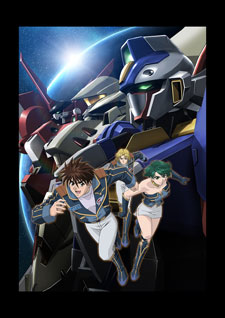 Logo handmade by Bannister
Column by Scott Green
Logo handmade by Bannister
Column by Scott Green
For thoughts on the top new mecha show coming out, check out AICN Anime's piece on Gurren Lagann Hopefully, there will be no hurtles in the series' release.
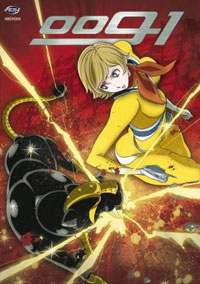
Anime Spotlight: 009-1 Volumes 3 Released by ADV Films
After a "bonus" episode that features the spy-vs-spy blowback from the first scene of the first episode, the final quarter of the 12 episode 009-1 series is a big, running escalating chain of events that builds a complete picture out of all of the people and concepts introduced in the anime's previous stand alone episodes. It was fairly obvious that 009-1 would recall some of the elements that it had previously introduced before the short anime series concluded, but apparently, it was planting charges all along. Detonating these in an explosive finale exceeds expectations. But, the anime's presentation suffers. The gadgets, the outfits, the backgrounds and the fight chorography that were all strange and gorgeous before become noticeable more perfunctory, as if director/character designer/chief animation director Naoyuki Konno ran out of time, budget or personal steam. As a complete series, 009-1 was still one of the most easily overlooked gems of 2007, but as satisfying as the scripting of its finale is, that last piece is missing the gleeful anime cyborg woman meets Avengers/Man From UNCLE excess of earlier episodes. One of the best inclusions of the Otaku USA print, anime magazine is its features on significant, less talked about creators who shaped or are shaping the anime tradition. For example, in the October 2007 issue, Tomohiro Machiyama dug into the works of Shotaro Ishinomori, introducing the creator of 009-1 as the "Japanese Stan Lee." Recognized as the creator of a number of the influential Ultraman-like live action tokusatsu works, including Kamen Rider and the bi-chromatic hippy robot Kikaider, as well as the anime/manga franchise Cyborg 009, Ishinomori's name deserves to be known by all fans of Japanese pop media. Like the work of his mentor Osamu Tezuka, Ishinomori introduced heavier subjects into what were children's works. Cyborg 009 famously ended with its hero sacrificing himself in a fall through the atmosphere in order to bring an end to a war provoking arms-dealer (though the character and franchise received a Sherlock Holmes style reprieve from death.) 009-1's distinction was that it served as Ishinomori's adult-male oriented seinen title. It's cyborgs for the Spike TV demographic. In place of heshin change sequences and other rituals, or robot dinosaurs and bugs, there's Mylene Hoffman. Also known as 009-1, she serves as a secret agent for the Western Bloc in their cold war conflict with the Eastern Bloc. In the noir tradition, the character might have some buried decency, but more often plays the role of the heartless woman. She's more likely to engender lust than love, and likely to greet sentimentality by a bullet's intimate contact. The series' trademark is the ace up Mylene's sleeve. In order to serve her country, she became a 009 cyborg secret agent. Among this cadre, the special customization in her construction is that she has machine guns built into her breast. It's the perfect armament of kiss-kiss, bang, bang work. As a prop for an anime series, what makes this bearable and interesting, as opposed to a conceit of unscrupulous characterization is that the anime is consistently half smart, half ironic in its mix of class and exploitation. This particular attack is depicted in silhouette in the anime's opening, and that's about as explicit as the series' get's in that regard. Which isn't to say that Mylene doesn't sleep with just about anything with a pulse in the line of duty, but the anime like's using the character as a fashion model as much as it does using her as a nude. The most prominent sign that the creative forces were directing their attention at wrapping up the plot nicely in this final stretch is that the anime finds few creative, new ways of presenting Mylene. More than early episodes did, these final episodes put the character in the role of damsel in distress. She manages to extricate herself, but it still features plenty of tie ups and tortures, and not much inventiveness. With a replay of the first episode's post coital showdown and passing a poison pill through a kiss, the final set of episodes wasn't quite as clever or classy in this flirtation with exploitation as it was in earlier sets. The final three episodes are both entirely satisfying and contrary to what had made the anime so distinctive. An ideal columniation of previously introduced component parts isn't what one might expect from a series that had been excelling at constructing small, strange set pieces that suggested a deeper world rather than a connected narrative. In presenting this it side steps expectations, in a way that isn't underwhelming or baffling. There is excitement to be gleamed in seeing 009-1, her cadre and the parallel department of the opposing nation in q Bond-ish global caper with a humanist, anti-imperialist, anti-exploitation message. As much as an anime starring a woman with machine-gun breasts, psychically detonated nuclear bombs and men with transparent domes in place of their skulls, can be straight, these episodes are: a more conventional sci-fi spies rather than uniquely anime take on the excess of the genre. For a series will a wildly provocative, love it or hate it, opening episode, as endearing as this ending might be for anyone who tried 009-1 and stuck with it, it is also disappointing that an anime that was manic or crazy for most of its run didn't end on a more memorable note.
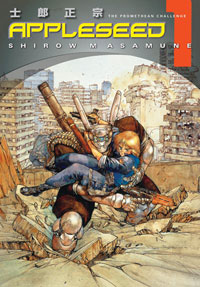
Manga Spotlight: Appleseed Volume 1: The Promethean Challenge Third Edition By Shirow Masamune Released by Dark Horse Manga
Someone, maybe Neil Gaiman or Christopher Cerf in the introduction for The Salmon of Doubt, once said something like "Douglas Adams was a world creator, who had to work as an author." I think the context was explaining why Adams had to be locked into a hotel room in order to finish a novel. Shirow Masamune is a schemer and tinkerer of worlds, who occasionally works as a manga creator or pin-up artist. In 1986's Seiun Award winning Appleseed, Shirow Masamune tries to channel his staggering ability for world creation into a long form narrative. Masamune's later works, namely Dominion and Ghost in the Shell frequently followed a sequence of cascading events that reflected the nature of the setting. Appleseed takes a more traditional route, with protagonists at the center of the conflict that defines their world. As a result, there's more of an effort to construct smoother story arcs and directly address the mysteries of the story's environment. The reason that his later manga followed more scattered or indirect narrative arcs might be that Masamune is not great at this traditional stuff. Without the pop of quick chapters and the focus on specific events, there are some dry spells, but, as always, his meticulous design is inspired, heady stuff. Volume 1 opens with a big action scene and doesn't really get to another until the end of the volume, after part of the nature of the conflict is revealed. It's not that one expects or should expect a shonen fight torment from Masamune. Within anime or the larger bounds of media, Masamune's work is singular, but fans who chiefly appreciate his rapid pace and sense of humor might not care for Appleseed as much as his other works. Those who admire him as an engine for introducing ideas and designs will definitely find a wealth to study in Appleseed. In addition to the features that one would expect from a Masamune work: cyborgs, painstakingly rendered guns, exo-armor robot suits, Masamune digs into social sci-fi. The manga explores notions of post-apocalyptic devastation and utopian societies. The manga introduces a world devastated by a global war. "Knowledge was lost. Confusion reigned. New powers rose to displace the old nations... Nuclear weapons themselves were never used. But even without them, the Earth became a quieter place." Later material expands on this, noting that chunks with the area of moderately sized countries were taken out of China, America and Russia due to meteor strikes. As the manga opens, former S.W.A.T. partners Deunan Knute, one of Masamune's militaristic heroines, and Briareos Hecatonchires, a big guy who's body has largely been replaced by cybernetic components, particularly noticeable for the large primary eye and rabbit ear like listeners on his head, are living in the wasteland, gathering food, trying to farm, and scrambling to survive in the absence of society. Here, Masamune manages to create a duo that engenders interest. Distinct from the context in which they are found, the idea of a woman from a future, mixed cultural background and a man who is largely no longer organic, both of whom are scarred veterans and in love with each other, is an intriguing concept to read about. Passing through a city that had been bombed out and exposed to sarin gas, the pair encounter a bandit piloted tank and a person in a power armor who had been seeking them. After taking out the former, they find that the latter is a young woman named Hitomi who has been searching for Deunan and Briareos to take then to Olympus, the home of the Central Management Bureau. While Deunan and Briareos were off in the wilderness, the CMB managed to supplant all of the old governments, forced a disarmament, instituted a unified trade system and built its ideal city of Olympus. An utopian city, with all dangers of power being exhibited by its rulers, surrounded by a bandit populated dystopian wilderness seems like it should be more exciting. Though Appleseed is told through the perspective of Deunan and Briareos walking further into the entanglements of the city, the function seems to be mapping out the society's design rather than telling a dynamic story. Prior to the CG version of the Appleseed anime, there was a cell animated OVA, produced in 1988. Unlike the dark cell shading of the newer anime, this was muted. Giant steel buildings were light grey. People, whether they were cops, terrorists or scheming officials, wore pastel tones. Though it was following the strain of violent OVAs, it looked a bit subdued. If you are interested in deconstructing Masamune's ideas, the manga offers plenty to work with, but if you're not predisposed to his vision, like the '88 anime, it's a bit muted. Shirow Masamune presents interesting ideas concerning the technology and architecture of Olympus. The attention he pays towards establishing how it works through his dialog and through the illustration, down to what bystanders in the background are doing, is staggering. But as conceptual sci-fi, he doesn't add to the idea of an over-managed society, with a segment of the populous revolting against their caged existence. The more considerable problem for non-Masamune fans is that the intrigue is not there. In particular, he doesn't offer enough to get excited about the factional infighting of Olympus' ruling bodies.

Manga Spotlight: Eden Volume 9 By Hiroki Endo Released by Dark Horse Manga
If only every story that made overtures at being politically informed could be as intensely dense and provocative as Eden... Those who didn't care for the recent phase of the series that witnessed its protagonist growing up by ushering him into a situation where he'd get his hands dirty in the world of drug dealers, addicts and prostitutes will be please to see the series return to its original track of mysterious infection, and global politics. In the case of the former, the manga has introduced a new, more vicious strain of the calcifying disease that killed 15% of the world's population in the series' first volume, but as far as this volume goes, it's more of a hint at where the thread is going than an active engagement. In the case of the latter, the sci-fi elements serve as a conceit to get engaged with true issues in the world. The conflict between Propater, a replacement of the UN representing the US, Japanese and Europe, and the rogue NOMAD serves as an umbrella for trends in modern conflicts. The thrust of the volume puts a face on the plight of minority ethnic populations. Specifically, it's China's Islamic Uyghur, but Native America, Japanese Ainu, Kurds, Basques, Celts, Tibetans and others are explicitly invoked. The vehicle by which Hiroki Endo investigates this is a hostage situation at the control facility for an oil pipeline in western China that serves as a proxy brushfire for Propater and NOMAD. More specifically, the scalpel for examining the situation is a type of personality that has not really emerged in this decade's conflicts: a charismatic and morally unignorable voice for the opposition/oppressed party. Marihan Ishaq is a young woman who is multi-lingual, articulate, and far sighted, both in the handling of the hostage situation and in the path for establishing a viable nation for her people. Broadcast around the world, she's a presence that puts Propater on the defensive. To that extent, Propater's plans for the media war and the shooting war are an indictment of how issues like this are handled. The statement 'Images like these only inspire sentimental interest with a shelf life of about ten minutes! In the end, people's own 'prosperous consumer lifestyle' is more important to them…' does not seem like an entirely unfair assessment. Robot drones and such add some sci-fi to the martial strategizing of the conflict, but in light of how the 2004 Russian/Chechnya hostage situation at the school in Beslan was resolved; the decision to deploy bio-engineer killing machines into the standoff doesn't seem that outrageously speculative. First released in Japan in 2003, Endo only pre-dated it by a year. The world isn't as small as some, maybe most, people envision it. Even though America has soldiers deployed in Afghanistan, it's disturbingly easy to know very little about Central Asia. You can be a dentist or software engineer or a plumber and know nothing about the history of the Uyghurs or the Uzbeks or the people of that, or any other part of the world, and there isn't necessarily a moral fault to that. What volume nine of Eden takes to task is the policies and complicit acceptance of policies that seek to brush away cultures in order to make it a small world. The pandemic disease based central conceit of Eden has been a device for breaking down national boundaries and speeding the roll-out of globalization. This expands on the discussion of the double edge sword that the movement represents; people lose their job-stuff is cheaper; oppression is globalized-terrorism/revolution is globalized; China has more of a reason to remove a distinct Uyghur identity-the Uyghur have the potential to tap their oil resources to sustain a nation. Endo excels at humanizing and articulating complex networks of concerns. There's as much going on in volume 9 of Eden as there is in a provocative novel or a very provocative movie. That makes the manga fascinating and significant, but it's not perfect. In some ways it is too subtle, and in others, it is far too unsubtle. The forceful insistence that makes the motivations of its characters tangible and the violence of its engagements distinctively inhumane becomes a liability when Endo is too obvious in trying to make his point. The specific case in this volume is when he demonstrates the cultural identity of the Uyghur people. Dancing, playing traditional instruments, they seem more like a National Geographic photo spread than a living community. Eden's track record is to provoke plenty of questions and ideas worth considering, and not to forward many theses. For better or worse, the tipping point always turns to drama that advances the story. Endo seems full of informed concerns and little certainty. That makes Eden an interesting platform for introducing issues, one that is worthy of consideration, and one that has no problem letting a question sit unanswered, unelaborated upon.
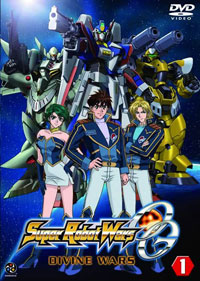
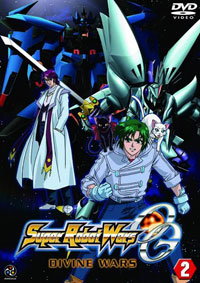
Anime Spotlight: Super Robot Wars Original Generation - Divine Wars Volumes 1 and 2 Released by Bandai Visual
In this column, I'd rather discuss the merit and appeal of a work of anime rather than recommending whether a consumer should purchase a release. But, there are exceptional values that warrant attention, and there is the inverse. Bandai Visual's releases are marketed to the dedicated anime consumer. The first, two episode volume of Super Robot Wars Original Generation - Divine Wars has an SRP of $39.99. The second, three episode volume has an SRP of $ 49.99. Factor in the 26 episode (if you count the OVA) run length of the series, and you get a proposition similar to Ken Kutaragi's suggestion that fans will want to work extra hours to afford purchasing a PlayStation 3. It's no secret that the North American industry is crashing against the rocks, trying to pull in consumers to buy DVDs of three to five episodes for $30.00. The medium is popular enough, but it's getting croaked by digital piracy. Consumer behavior seems to suggest that a model of inexpensive digital releases of individual episodes, and physical media of complete sets might work, but with challenges in licensing the anime and selecting the right digital vehicle, no distributor has figured out how to build that system. With Patlabor or Gunbuster or Wings of Honneamise or Jin-Roh, you can find some dedicated fans to scrape together the cash for an enduring, pricey release. Super Robot Wars Original Generation - Divine Wars... it's nice mecha fanservice. Fans of the genre will appreciate its mecha designs and its in-joke characters work, but with the available funds, it hard to make a case for this over finally picking up a Chogokin figure on eBay. The Super Robot Wars strategy games series, also referred to under its original Japanese name, Super Robot Taisen, so as to not infringe on the once televised robotics competition, is famous for brining together the pantheons of robot action anime. The original Nintendo Game Boy game featured both "super robots" from Go Nagai's library, including Mazinger Z and Getter Robo, and "real robots" from Gundam. Later games would feature everything from Neon Genesis Evangelion to Escaflowne, to Full Metal Panic. As the title suggests, the "Original Generation" games strictly featured work created by Banpresto for the series, and not the pre-existing characters or mecha from anime. Because this subset of the series could be released without untangling all the IP involved, Atlus has released two of the Original Generation games for the Game Boy Advance in North America. Divine Wars follows the Ryusei Date storyline from the first of these Original Generation games. At least in these early episodes, the anime doesn't decouple itself from the workings of the games and Ryusei Date doesn't transcend his game role as a point of view. He's a mecha geek himself, with an innate gift makes him a desirable candidate for piloting a secretive organization's bleeding edge robots. Other than his idealism and his meta-commentary in which points out the similarities between his circumstances and giant robot anime conventions, he's a cipher. The characters around him are people you'd want to fight with or against in a game. The impression that they foster is either that they are eye catching and seem to present an intriguing possibilities in terms of in-game capabilities or that they're heels that you'd personally want to work to defeat. Within an anime series, they seem like a parade of templates. There's the duty bound aristocrat, the silent young genius girl, the guy of African descent who’s listening to music and dancing (I'm not joking), the ace with the weird hair... The antagonist raises some interest because he's such an evil geek jackass, but again, he seems like a game-foe. In the anime, it doesn't seem entirely credible that his superiors would put up with his antics. There’s a lingo heavy, detail heavy background of world building to the series. After humanity established a foothold in space, two asteroids crashed into Earth. These yielded Extra-Over Technology or EOT, and mankind used it to start building their own defenses (giant robots) to defend itself against inevitable contact with alien races. This spurred a arms race/multi-front conflict between various human factions and the alien Aerogaters. Presenting some of this through info dumps and obfuscating the rest points to origins as a game that was offloading a lot of information between missions. Though Super Robot Wars' characters aren't inspiring, its mecha are. Hajime Katoki, best known for redesigning the Gundam mecha after the original series, and Kunio Okawara, one of the top names in anime robot designs from Gatchaman to GaoGaiGar, demonstrate why they represent the top of their field in putting together the wide host of machines presented in Divine Wars. They point to recognizable hallmarks from Gundam, Macross and the like while ensuring that they aren't simply producing generic knock-offs. The action itself follows strategy game origins of Super Robot Wars and as such seems too blocked out and limited, but, rendered in 3D CGI, the robots are animated with an impressive degree of detail that should capture the attention fans who build models and study the minutia of mecha design. Even if Divine Wars was inexpensive, it would warrant a very qualified recommendation. One has to be a particularly dedicated mecha fan for it to be worth one's time, let alone the purchase cost. As appealing as the designs are for a mecha fan, the broad tribute to the conventions of the genre leverages that appeal rather than presenting an involving narrative.images (c) SRWOG PROJECT All Rights Reserved.
Adult Swim Picks Up More Bleach
VIZ Media, LLC has announced that the 52-episode second season of the hit supernatural action animated series BLEACH is expected to begin airing on Saturday, March 1 on Adult Swim. BLEACH follows Ichigo Kurosaki, an ordinary 15-year-old boy who also happens to be able to see ghosts. His fate takes an extraordinary turn when he meets Rukia Kuchiki, a Soul Reaper who shows up at Ichigo's house on the trail of a Hollow, a malevolent lost soul. Drawn to Ichigo's high level of spirit energy, the Hollow attacks him and his family, and as a last resort, Rukia decides to transfer part of her Soul Reaper powers to Ichigo. As a result of Rukia’s actions, she is sent back to the Soul Society, where she is condemned to die. In Season 2, a stronger and more powerful Ichigo demonstrates a new resolve to save Rukia from certain death. This culminates in an explosive confrontation with Byakuya Kuchiki, Rukia’s by-the-book brother and his most intense opponent yet! Soon, Ichigo’s journey takes him back to the World of the Living where he must deal with a new assortment of supernatural enemies as well as the rigors of high-school life.
Why We Love Kazuo Umezu
Via Same Hat! Same Hat!, horror manga great Kazuo Umezu...

